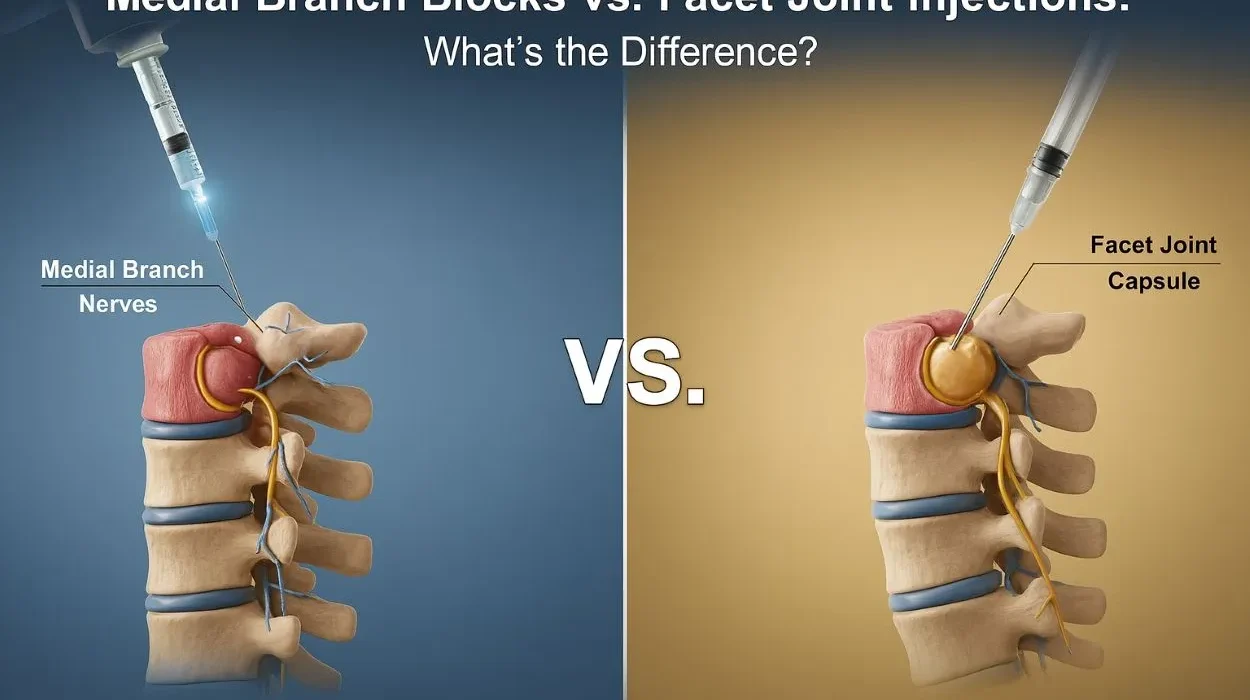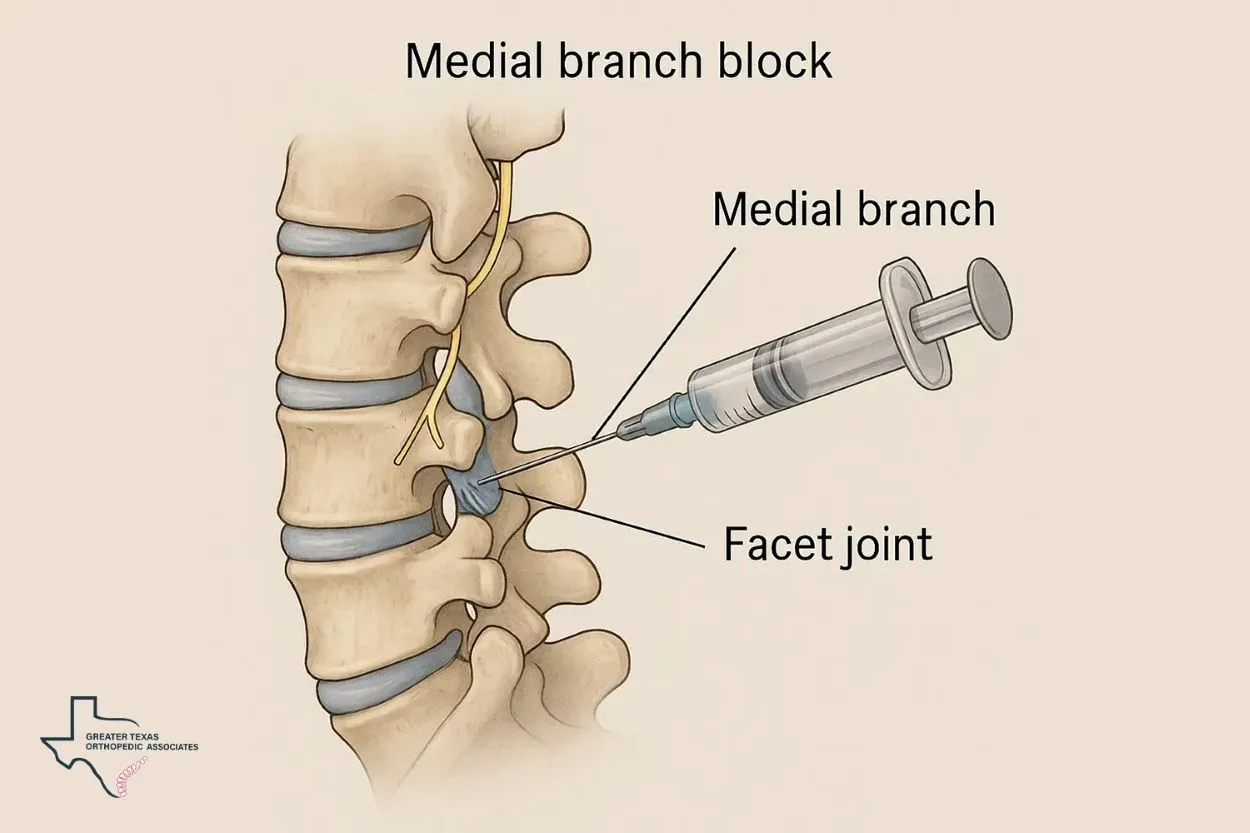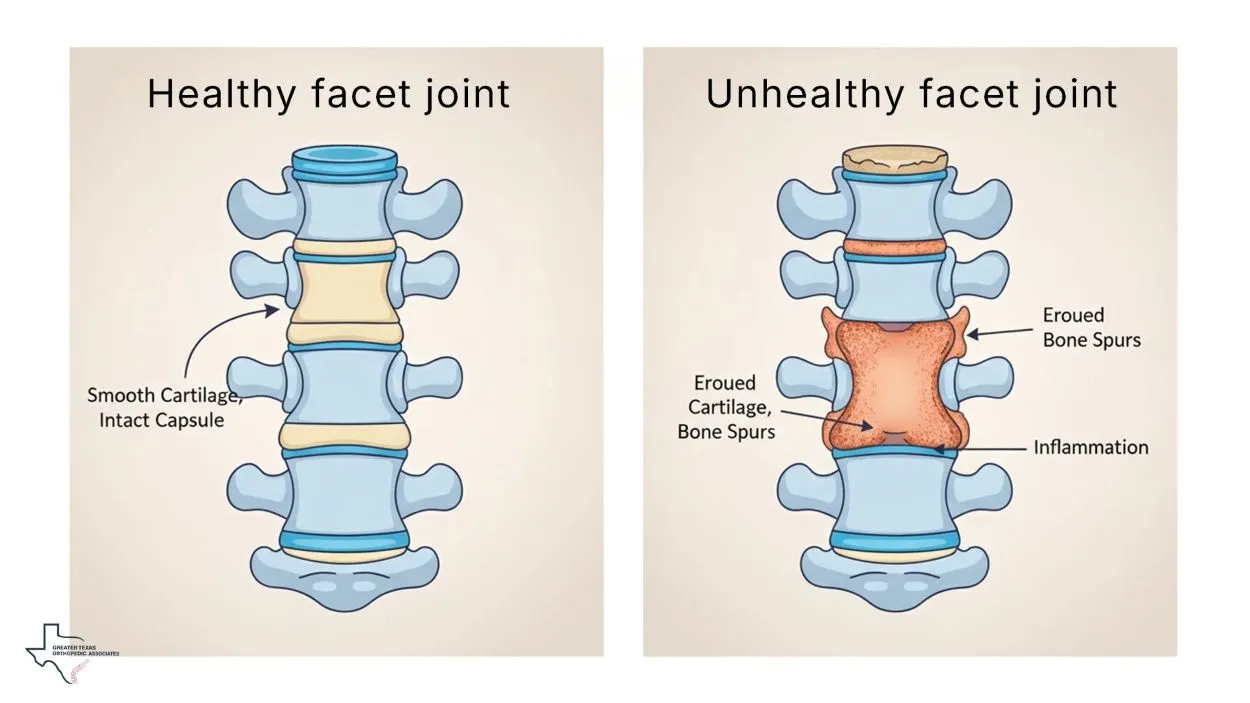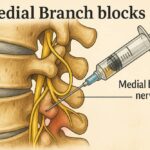Medial Branch Blocks vs. Facet Joint Injections: What’s the Difference?
Imagine waking up each day with a persistent ache in your back or neck, making simple movements a challenge. You’re not alone; chronic low back pain (CLBP) affects approximately 15%–30% of adults at any given time, with a lifetime prevalence exceeding 70% in industrialized countries, making it a leading cause of disability worldwide. For many, this debilitating discomfort originates from the small yet critical facet joints in the spine. When these joints become inflamed or arthritic, they can significantly impact quality of life.
To pinpoint and treat this specific type of spinal pain, medical specialists often turn to targeted injections. Two of the most common and effective interventional pain management techniques are Medial Branch Blocks (MBBs) and Facet Joint Injections (FJIs). While both aim to alleviate pain stemming from the facet joints, their primary purposes, mechanisms, and outcomes differ significantly. When comparing treatments, many patients specifically search for medial branch block vs facet joint injection, and understanding their differences is crucial.
Understanding Facet Joint Pain
At the core of many chronic spinal pain complaints are the facet joints, also known as zygapophysial joints. These small, cartilage-lined synovial joints connect adjacent vertebrae, providing crucial stability and enabling the spine to move through various motions, such as flexion, extension, and rotation. However, they are highly susceptible to wear and tear, including arthritis, degeneration, inflammation, and injury, which can lead to pain.
Lumbar facet joint pain is a significant contributor to chronic low back pain, accounting for 15-45% of all etiologies. This pain often manifests as axial low back pain, which can worsen with spinal extension or prolonged standing. It may radiate into the buttocks, hip, and back of the thigh, typically stopping at the knee for lumbar irritation, or into the neck, head, and shoulders for cervical irritation. Pinpointing facet joint pain through traditional imaging like MRI or CT, can be challenging due to their lack of specificity. Therefore, specialized diagnostic injections are essential tools for accurate diagnosis and effective facet joint pain treatment options.
Medial Branch Blocks (MBBs): The Diagnostic Key
A Medial Branch Block is a precise injection that serves primarily as a diagnostic tool to identify if the facet joints are indeed the source of your pain. It involves injecting a local anesthetic near the medial branch nerves, which are the small nerves responsible for transmitting pain signals from the facet joints to the brain.
Purpose:
The main goal of an MBB is to temporarily block these specific pain signals. If you experience significant pain relief after the injection—typically defined as at least 50% relief for the expected duration of the anesthetic—it strongly indicates that the targeted facet joints are the pain generators. This diagnostic clarity is crucial for guiding subsequent facet joint pain treatment options, such as radiofrequency ablation (RFA). A positive response to MBB is often a strong predictor of the success of RFA.
Anatomy in Focus:
The medial branches of the spinal dorsal ramus are key because they innervate the facet joints. Each facet joint receives innervation from medial branches originating from two adjacent spinal segments. For example, the L4-5 facet joint is supplied by medial branches from the L3 and L4 dorsal rami, while the L5-S1 facet joint receives innervation from the L4 medial branch and the L5 dorsal ramus. These nerves run in a fibro-osseous canal, bounded by the accessory process, mammillary process, and mammilloaccessory ligament. Precision in targeting this area is critical for accurate diagnosis.
The MBB Procedure: What to Expect
The MBB procedure is typically performed in an outpatient setting, often guided by real-time X-ray (fluoroscopy).
Preparation:
Your doctor will review your medical history, current medications (especially blood thinners, which may need to be stopped several days prior), and any allergies. You may also be advised to avoid eating or drinking for a certain period before the procedure. A responsible adult should be available to drive you home, especially if sedation is used.
During the Procedure:
You will lie on your stomach on an X-ray table. The injection site will be cleansed with an antiseptic, and a local anesthetic will numb the skin. Using fluoroscopy, the physician carefully guides a thin needle to the targeted medial branch nerves. A small amount of contrast dye may be injected to confirm accurate needle placement. Finally, a local anesthetic is injected, sometimes combined with a steroid.
Recovery and Efficacy:
After the injection, you will be monitored for about 30-60 minutes. It’s normal to experience temporary numbness or mild soreness at the injection site. The pain relief from the anesthetic is temporary, usually lasting hours to a few days (1 to 7 days).
Why Two Blocks?
Due to the possibility of false-positive responses from a single injection, two diagnostic medial branch blocks, performed 2-3 weeks apart, are often recommended to confirm the diagnosis of facet joint pain. This step is especially important when evaluating options in a “medial branch blocks vs facet joint injections” decision.
Success Rates and Next Steps:
Studies show that more than half of patients experience at least 80% improvement in pain after a successful diagnostic medial branch block. If two such blocks independently confirm facet joint pain at the same spinal level, there is approximately a 60% chance of achieving significant and lasting pain relief with RFA treatment of those medial branch nerves. For patients with positive diagnostic blocks, the next step is typically Radiofrequency Ablation (RFA) for longer-lasting pain relief.
📌Learn more about Medial Branch Blocks: [Medial Branch Blocks: Uses, Procedure, Benefits, and FAQs].
Facet Joint Injections (FJIs): Direct Relief to the Joint
Facet Joint Injections involve delivering medication directly into the facet joint capsule itself. While they can have diagnostic value, they are primarily considered a therapeutic intervention aimed at reducing inflammation and pain within the joint.
Purpose:
The main goal of an FJI is to alleviate pain by reducing inflammation inside the joint. The medication, typically a combination of a local anesthetic and a corticosteroid, targets the inflamed tissues within the joint capsule. Studies suggest that FJIs can provide therapeutic relief for 2 to 4 months or longer.
Distinction from Steroid Injections:
It’s important to clarify that “facet joint injection” refers to the location of the injection (the facet joint), while “steroid injection” describes the type of medication used. FJIs often contain steroids, particularly for their anti-inflammatory effects.
The FJI Procedure: What to Expect
Like MBBs, FJIs are minimally invasive procedures typically performed in an outpatient setting under imaging guidance.
Preparation:
Similar to MBBs, this includes a thorough medical history, review of medications (e.g., blood thinners 2-7 days prior), and a physical exam. Imaging, such as X-rays or MRIs, can help assess damage or inflammation of the facet joint. Sedation is usually avoided to allow for accurate pain assessment, but anti-anxiety medication may be offered. A driver is needed if sedation is administered.
During the Procedure:
You will be positioned on your stomach (prone) for lumbar injections, or on your stomach or side for cervical injections. The injection area is cleansed and numbed. The needle is guided into the targeted facet joint using fluoroscopy or ultrasound. Contrast dye is injected to confirm the needle is correctly placed within the joint capsule and not entering the bloodstream. The medication (local anesthetic and corticosteroid) is then injected.
Recovery and Efficacy:
You will be monitored for 30-60 minutes post-procedure. Initial pain relief from the local anesthetic may be felt within hours. However, a temporary increase in pain or a “steroid flare” can occur before the corticosteroid’s anti-inflammatory effects begin, typically within a few days. Relief from the corticosteroid can last for 2 to 4 months or even longer, with a high success rate of up to 80% for appropriate candidates. Most patients can return to normal activities the day after the procedure, with advice to gradually increase activity over one to two weeks.
📌Discover more about Facet Joint Injections: [All About the Facet Joint Injections Procedure].
Learning the details of each procedure makes the comparison of “medial branch blocks vs facet joint injections” easier for patients considering their next step.
Medial Branch Blocks vs. Facet Joint Injections: Key Differences for Informed Decisions
Understanding the distinct characteristics of these two facet joint pain treatment options is crucial for effective spinal pain relief.
Primary Purpose:
Medial Branch Blocks (MBBs) are primarily diagnostic. They help identify if the facet joints are the source of pain, typically as a precursor to a more long-lasting treatment like RFA. A positive response confirms facetogenic pain and predicts RFA success.
Facet Joint Injections (FJIs) are primarily therapeutic. They deliver medication directly into the joint to reduce inflammation and pain, providing direct relief. While they can have diagnostic utility, MBBs are considered more precise for predicting RFA success.
Target Location:
MBBs target the small medial branch nerves located outside the joint space, near the bony structures that form the facet joint. The needle is placed in the fibro-osseous canal, near the accessory process, or the junction of the superior articular process and the root of the transverse process.
FJIs involve injecting medication directly into the facet joint capsule.
Medication Used:
MBBs primarily use a local anesthetic (e.g., lidocaine, bupivacaine) to temporarily numb the nerves. Corticosteroids may or may not be used, and routine use, especially with cervical MBBs, is often avoided.
FJIs typically use both a local anesthetic and a corticosteroid (e.g., dexamethasone, triamcinolone, methylprednisolone) to provide both immediate numbing and sustained anti-inflammatory effects.
Duration of Pain Relief:
MBBs offer short-term relief, typically lasting a few hours to a few days, serving as a temporary diagnostic window.
FJIs aim for longer-term therapeutic relief, often lasting 2 to 4 months or more, thanks to the corticosteroid’s sustained anti-inflammatory action.
Patient Satisfaction and Adverse Effects:
A systematic review and meta-analysis found that Facet Joint Injections were associated with significantly higher patient satisfaction compared to Medial Branch Blocks (Odds Ratio, 1.81; p=0.04). This may be due to the more immediate pain relief and a perceived smoother procedural experience with fewer complications associated with FJIs.
FJIs were also found to have fewer adverse effects than MBBs. Common side effects for FJIs are generally mild and transient, including pain, tenderness, swelling, numbness, minor bleeding at the injection site, or a “steroid flare”. Corticosteroid-related side effects, such as fluid retention or hyperglycemia, can occur.
MBBs have a slightly higher complication rate, primarily due to their proximity to neural structures. Reported adverse effects include temporary numbness or weakness, vasovagal reactions (dizziness, nausea, sweating), neuritis, or prolonged dysesthesia. The risk of vascular injury, hematoma, or inadvertent intravascular injection is also slightly higher for MBBs than for FJIs, particularly without proper imaging guidance.
However, both procedures are generally safe when performed by experienced physicians using imaging guidance. Knowing these safety profiles is part of weighing a “Medial Branch Block vs Facet Joint Injection” choice with your pain specialist.
When is Each Procedure Recommended?
The choice between an MBB and an FJI depends heavily on the suspected nature of your pain and the overall treatment goal.
Indications for Medial Branch Blocks:
- Used when facet joints are suspected as the source of chronic spinal pain (cervical, thoracic, or lumbar regions).
- An essential diagnostic step before considering radiofrequency ablation (RFA) for longer-lasting relief.
- Conditions often investigated include facet joint osteoarthritis, spinal osteoarthritis, degenerative spondylolisthesis, rheumatoid arthritis, ankylosing spondylitis, and scoliosis.
Indications for Facet Joint Injections:
- Indicated for arthritis of the spine, degenerated discs causing facet issues, or inflammatory arthritis affecting the spine.
- Useful for axial back pain or neck pain (not radiating down the arm or leg).
- Often considered after conservative therapies (oral medications, physical therapy) have been tried for at least 3 months without sufficient relief.
Contraindications / When Not Recommended (for both):
- Active systemic or local infection, bleeding disorders, and pregnancy.
- Known allergies to the medications or contrast dye.
The Role in a Comprehensive Pain Management Plan
Both MBBs and FJIs are integral components of a comprehensive facet joint pain treatment strategy at GTOA. They are typically not standalone solutions but rather steps in a broader plan aimed at providing sustainable spinal pain relief.
Guiding Treatment Decisions:
A successful diagnostic MBB provides clear direction for subsequent procedures like Radiofrequency Ablation (RFA), which can offer relief for six months to a year or even longer. Similarly, therapeutic FJIs can provide a window of pain relief, enabling patients to engage more effectively in physical therapy and rehabilitation.
Beyond Injections:
These injections are often combined with other therapies, such as physical therapy and targeted exercises, to strengthen the muscles supporting the spine and improve overall function. GTOA’s team emphasizes personalized care, crafting treatment plans that feel right for every patient, leveraging over 70 years of experience in pain management.
Conclusion:
Choosing the right facet joint pain treatment option is a pivotal step toward regaining control over your life. While Medial Branch Blocks are invaluable for accurately diagnosing the source of your pain, Facet Joint Injections offer direct therapeutic relief. This balanced understanding of “medial branch blocks vs facet joint injections” helps patients and physicians create the most effective, individualized treatment plan.
Both are effective strategies for managing facet-mediated spinal pain, playing distinct yet complementary roles in a comprehensive care plan. Patient satisfaction is significantly higher with FJIs, and they are associated with fewer adverse effects compared to MBBs.
At Greater Texas Orthopedic Associates, our experienced team of pain management specialists, including Dr. John Hall, is dedicated to providing personalized solutions. By thoroughly understanding your unique condition and treatment goals, we can guide you through these options, ensuring you receive the most effective and appropriate care for lasting chronic low back pain relief and improved quality of life.
Take the next step toward a pain-free future. Schedule a consultation with a GTOA pain management specialist today to determine the best approach for your unique condition.
Contact us or find a location near you to schedule your consultation today.







2 Comments
Excellent post. I really appreciate how clearly the information is presented.
The balance between medical details and legal insights makes it incredibly helpful for both attorneys and patients in Texas.
Thank you Emily, This is our honor.